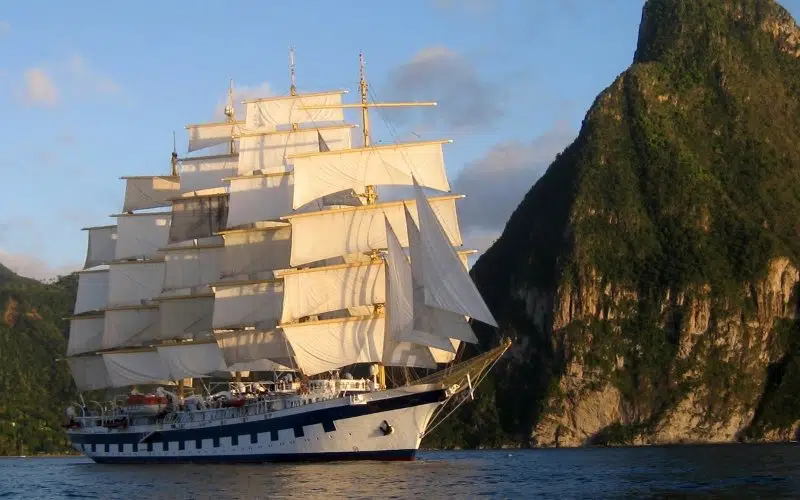What is a Clipper Ship – History, Development And Characteristics
A clipper ship is a synonym for a merchant ship from the 19th century that plied global routes and ferried cargo and passengers.
In the 1840s, a new kind of merchant navy vessel was created by American shipbuilders. It facilitated faster transport of cargo through the oceanic waters.
These ships were later incorporated by the English shipbuilders, and the clipper ship started becoming popular worldwide.
In its way, the clipper ship revolutionized water transport, thanks to its speed even while transporting cargo.
The most important aspect of a clipper ship was speed, and it was built to enhance a streamlined design and enable cargo owners to maximize revenue while keeping costs down.
A clipper ship had three masts with square sails covering every feasible coverable area on the mast.
This unique mast-and-sail combination also enabled the clipper ships to gain the immense popularity they enjoyed in the mid-to-late 19th century.
In this article, we dive into the world of clipper ships, their role in sustaining the global economy during its 19th-century boom, and the generations of vessels they inspired.
History of Clipper Ships
The origin of the term “clipper ship” in naval architecture is disputed. But the consensus is that the Baltimore Clipper was the first vessel to employ that name.
It was part of the American shipbuilding spree that gripped the nation in the 18th-19th century. The other maritime contemporaries of the Baltimore Clipper were Pilot-boat, Virginia Built, and Baltimore Built vessels.
A possible theory suggests that the term “Baltimore Clipper” was shortened to “Clipper”, giving rise to the now-popular name.
The term clipper originated in English texts and was followed by its prominent use in America. Being a fast and able vessel, the clipper ship gained popularity, and the term became mainstream by the second half of the 19th century.
The phrase “to clip” means “to proceed at a swift pace”, which explains the origin of the term clipper.
The East India Company was a major driving force in creating a demand for goods in Asia and Europe. They employed fast clippers to keep a constant supply of goods between these locations and India.
The Chinese clippers plucked these routes and were touted as some of the fastest ships. Even today, they rival the speed of modern commercial vessels.
Opium was a fast-selling commodity in Britain and China, with annual consumption far exceeding the production capabilities of the East India Company.
Tea was another commodity in high demand in British society. Produced in the plantations of China and India, they required short voyage times to retain cargo freshness.
To meet this growing requirement for high-quality tea and Opium, the British turned to a new class of clippers operating from Asia- the Opium and Tea clippers.
These vessels featured extremely high deadrise angles built and operated by Chinese and Arab merchants and handled by Indians and Far East Asians.
They had high beams above the waterline to compensate for the lost space and used extra sails to quicken the journey around the Cape of Good Hope.
Development and Subsequent Decline of the Clippers
Clippers were covered in sails on every possible inch of the mast to meet the requirements of being classified as a “fast” ship.
The famous clippers of the 19th century were predominantly constructed out of Britain, America, Brazil, France, and the Netherlands. They were capable of making trans-Atlantic voyages with their fast speeds.
Common routes included Europe-America’s passenger and cargo trips, trade to and from the UK, China with tea, spices, and Opium, and Java with labourers.
A celebrated route was the San Francisco-New York journey that supplemented commerce during the Gold Rush. Operational before the construction of the Panama Canal, this route went around Cape Horn (the southernmost tip of South America) and ferried passengers between both coasts of the United States.
Clippers were in high demand during spikes in the economic boom, especially in Europe, America, and Asia. For instance, the Gold Rush resulted in American shipyards constructing numerous clippers to meet customer demands.
The increase in tea consumption, farming of Opium, and import of textiles from India to the West further spurred the clipper industry.
Although clippers experienced a decline following the American Civil War and the Crimean War, British shipyards continued to build high-quality and fast vessels.
They developed the concept of composite hulls to maximize strength and durability while cutting down on weight, much like modern composites that provide the best of both worlds. British clippers operating from the latter half of the 19th century included copper sheathing, wooden planks, and iron spars.
Ultimately, the construction of the Panama Canal and the opening of the Suez Canal led to a gradual decline in the use of clipper ships. Travel times were further reduced, and the ability to carry oversized cargo shipments was the need of the hour.
Fast travel was no longer necessary since commodities were required in bulk and had to be consistently supplied by the shipper.
While some clippers modified the under-deck hull to accommodate more cargo while sacrificing speed, their construction declined by the 20th century. They were replaced by faster and fuel-efficient models powered by diesel engines and steamships.
Characteristics of a Clipper Ship
A clipper ship offered its captain and crew a sailing speed of over 250 miles a day, whereas the routine ships travelled at an average speed of 150 miles per day. In earlier times, covering 250 nautical miles in a day was a long journey.
The origin of a clipper ship was spurred by that time’s predominant slow-moving water transportation.
With competition to bring Chinese tea into the goldfields of California before the first tea leaves of the season were sold out, competent shipbuilders and innovative naval architects created the sleek signature design of a clipper ship.
Clippers are broadly recognized as belonging to one of three categories based on their design:
- High deadrise clippers
- Medium deadrise and entire mid-section clippers
- Combinations of a sharp deadrise with a fuller mid-section
Some of the important terms used to define clipper designs are as follows:
- Deadrise angle – The angle between a horizontal plane through the keel and a plane passing through the hull bottom from the keel to a point where a radius of curvature is first introduced.
- Mid-section – The area enclosed by a ship’s hull on a transverse plane passing through the midship region of a vessel.
To assess the hull design, the “fullness” of the hull is often used to measure hydrodynamic performance. Fullness measures how close a hull shape is to an enclosing rectangular cuboid of dimensions equal to a ship’s longest dimension (length, beam, draft).
By using the draft, we compare the underwater volumes of these types of ships. The technical factors used by naval architects during the design phase are the “prismatic coefficient” and “block coefficient”. The prismatic coefficient is more widely used since it compares the underwater volume with an equivalent prism rather than a rectangular cuboid.
Size-wise, each clipper ship varied. But their cargo was anywhere between a few hundred to 4000 tons. Tons, in the case of a ship’s weight, meant the number of tons of wine a ship could carry rather than a ship’s equivalent weight in pounds.
And in the case of a clipper ship, the tonnage is significant because even if the ship was designed for speed and mobility, piling extra cargo loads meant the owner losing out on not just precious cargo but also an entire ship during a capsize.
Another set of definitions used to classify clippers are as follows:
- Extreme clipper – Extremely sharp hull forms but with reduced under-deck tonnage capacity. The primary source of income is the speed and promise of multiple voyages at a fraction of the time of similar sea-going vessels.
- Medium clipper – Mid-Lesser hull sharpness but better under-deck tonnage than an extreme variant. These clippers are fast and allow more oversized cargo to be shipped. They were favoured for voyages that were not urgent and had flexible schedules.
- Standard clipper – These variants were a cross between extreme and medium clippers. They came with the speed of powerful clippers but also had sizeable under-deck tonnage.
Famous Clipper Ships and Surviving Vessels
Amongst the wide range of clipper ships that dominated the era, quite a few famous ones carved their place in the pages of shipping history. Of these renowned clipper ships, the Flying Cloud (which was launched in 1851) was a significant American clipper ship, as it made the journey between New York and San Francisco in 89 days – a record by itself. The Lightning created another form by cruising and covering 436 nautical miles in just 24 hours.
But more than these two clipper ships, there is one more great clipper that needs special mention. The Cutty Sark was a clipper ship built in 1869. It was the last clipper ship to be built and now stands on dry dock in Greenwich, London. The biggest attraction of this clipper ship is that it is the last original clipper ship that is still available in physical form.
Other famous clippers set records for fastest sail times between regular routes. The Sovereign of the Seas was the quickest ship in 1854 but was ousted by swifter and finer models in subsequent years.
Clipper models included schooners, brigs, and brigantines that were fast and capable of long voyages. By enlisting full use of the multiple sails on the three masts, these vessels were capable of reaching speeds that also made them familiar during warfare.
The British Blockade during the American Revolution was characterized by the widespread use of clippers to snipe at enemy positions while remaining safe owing to the vessel’s speed.
A clipper ship was a pioneer of water transport in the 1800s and even today holds a very relevant place in the development of the transportation mode.
Post the industrial revolution, and after the world started to get modernized, steamers and other top-line ships came into existence, making things far easier for people who wanted to have an experience of transportation by water – for themselves as well as for their cargo.
But even amid these developments and transformations, the share and contribution of a clipper ship in water transportation is something that deserves and merits immense acknowledgement and appreciation from across the world.
If you liked this article, you might also like to read Knowing the Legendary Mayflower that sailed from Europe to America, bringing some of the first Pilgrims and Puritans to The New World.
Frequently Asked Questions on clipper ships
1. Why are they called clipper ships?
Clipper ships were named so due to their fast pace or speed, as these vessels gained propulsion from the winds. In the 19th century, they represented great technological advancement in shipping.
2. What were clipper ships used for?
Clipper ships were built in Britain, Brazil, France, America and the Netherlands for shipping high-value freight like tea from China. They were used for supplying provisions and other goods to California during the Gold Rush.
3. Why were clipper ships so fast?
The answer lies in their constructional design. The fastest ships in the 19th century had narrow hulls gliding through the water easily. Most of their area was covered with sailing masts. Hence a larger sail area meant they could catch more wind. Cutty Sark was one of the fastest clippers, had about 3000 m of sail, and could attain a speed of 31 kph.
4. How long it took clipper ships to cross the Atlantic?
5. What replaced the clipper ships?
The era of the clipper ships ended when they were rolled out in favour of more modern and advanced iron-hulled ships, with greater cargo-carrying capacity, as now commodities were required in bulk. After this, steamships became popular.
Disclaimer: The authors’ views expressed in this article do not necessarily reflect the views of Marine Insight. Data and charts, if used, in the article have been sourced from available information and have not been authenticated by any statutory authority. The author and Marine Insight do not claim it to be accurate nor accept any responsibility for the same. The views constitute only the opinions and do not constitute any guidelines or recommendations on any course of action to be followed by the reader.
Do you have info to share with us ? Suggest a correction

About Author
Shilavadra Bhattacharjee is a shipbroker with a background in commercial operations after having sailed onboard as a Third Officer. His interests primarily lie in the energy sector, books and travelling.
Subscribe To Our Newsletters
By subscribing, you agree to our Privacy Policy and may receive occasional deal communications; you can unsubscribe anytime.





Fascinating article. Thank you.